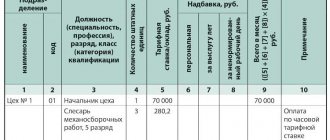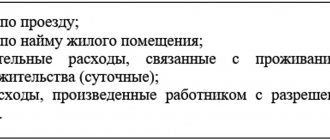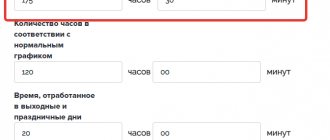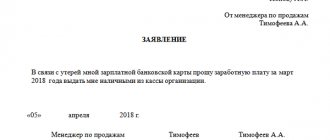Who should pay VAT. Can an individual entrepreneur work with taxes?
This is an indirect tax at the federal level, which involves the withdrawal of part of the added value of a product to the state budget. The final consumer pays the tax amount, since the amount is included in the price. The buyer is the actual payer of this tax.
Enterprises that sell goods or services are considered legal payers. The individual entrepreneur makes the calculations and pays the funds to the state budget. To do this, you need to register with the tax office.
VAT payers:
- Individual entrepreneurs who carry out taxable transactions.
- Organizations carrying out taxable transactions.
- Persons who transport goods across the customs border of the Russian Federation.
VAT is the difference between the proceeds from the sale of goods and the amount paid for raw materials purchased from third parties. Some types of activities, as well as special goods and services, are exempt from VAT in full or in part. The tax amount is collected in advance, without taking into account the fact of sale of the goods.
Loans
With the help of loans, you can defer the payment of VAT for a quarter or more. To do this, the seller takes a loan from the buyer equal to the advance amount. After shipment, the debt for the goods sold and the loan are offset. Since loans are not subject to VAT, tax will only be charged on the sale of goods.
This scheme does not break the law, but it does have its risks. Firstly, the tax office is well aware of the scheme and is wary of it, so it will not be possible to use this technique regularly. Secondly, it is not profitable for the buyer to postpone the tax payment deadline or give a loan, so it is important to take into account the interests of the buyer.
Pros and cons of working with VAT in 2021
The Tax Code provides the opportunity to choose how to work: pay tax and work on OSNO or choose a simplified system without tax. At first glance, it is easier to refuse to pay additional fees. But entrepreneurs do not always understand how their activities can benefit from this situation.
The absence of a VAT line in an invoice often closes a businessman’s path to profitable deals. Organizations are looking for the same tax payers as partners. This is a problem for small businesses.
Pros of use:
- Large enterprises do not work with contractors who do not pay VAT. Refusal to pay reduces the competitive attractiveness of a business.
- An organization has the right to a tax deduction if it purchased goods/materials from a supplier with VAT included. This is a real saving if the price is favorable compared to suppliers' offers without this tax.
Disadvantages of use:
- The need to carefully verify primary documents and check suppliers.
- Responsibility for maintaining accounting books and tax registers.
- Submission of declarations.
One mistake in calculations leads to large losses. Therefore, the tax authorities more carefully check individual entrepreneurs who pay VAT, in contrast to entities on simplified systems.
Flaws
The disadvantages of working with this tax are somewhat greater than the advantages. These include:
- Obligation to pay 20% tax. And although it is included in the final cost of the product, and the tax itself is paid by the buyer, its presence often reduces the customer base.
- VAT is quite complex within the framework of document flow, which imposes additional difficulties when maintaining accounting records. Departments are required to maintain registers, regularly submit declarations and inspect additional facilities.
- Purchase, being on a simplified taxation system, from suppliers who pay VAT. Thus, it will not be possible to make a deduction even if an invoice is used.
As a result, working with VAT is ideal for large enterprises. This allows you to get more partners who already have enormous resources so that VAT is not a problem for them. This tax is a hindrance only when it is imposed on small enterprises.
Peculiarities of working as an individual entrepreneur with VAT
An individual entrepreneur must pay VAT if he works under the general taxation system. The payer is obliged to do the following:
- Issue invoices to counterparties.
- Pay tax bills.
- Submit a declaration to the tax office at the place of registration. You can only fill out the title page and the first section.
The allocation of VAT in the invoice should not oblige you to pay this tax. But this may raise questions among inspectors.
If an entrepreneur issues a VAT invoice to a counterparty, he automatically becomes a payer of this tax. If an individual entrepreneur is on the simplified tax system “income minus expenses” and must pay VAT, then this amount can no longer be included in “expenses”. And also with UTII, the amount of tax paid to the supplier is not accepted for deduction.
If an individual entrepreneur works on the simplified tax system, then he is not obliged to pay VAT, and, accordingly, should not issue this type of tax to contractors in the invoice.
Accurate accounting to reduce VAT
The amount of VAT depends on proper accounting. To avoid an overestimated tax amount by the end of the quarter, follow these rules:
- add all incoming acts, invoices and invoices to your accounting system;
- request advance invoices from suppliers;
- issue invoices to customers;
- check that all invoices received from suppliers are posted in the system;
- check that the system has not calculated VAT twice: to do this, check the link to accounts and contracts in incoming payment orders and outgoing acts and invoices;
- check the same in outgoing payment orders and incoming acts and invoices.
Web service for small and medium-sized businesses Kontur.Accounting will automatically check all VAT items in order to minimize the amount payable. The service will tell you what exactly needs to be done or checked in accounting.
How much to pay and when
In the Russian Federation the rate is 18%. For some types of goods, a reduced rate of 10% is provided: children's goods, food products, agricultural products, printed publications.
The tax period is a quarter. Each quarter has 3 months. The payment amount is set for a quarter and is paid in three equal installments every month, no later than the 25th. For example, for the first quarter of 2018, you must pay in three equal installments by April 25, May and June 2018, respectively.
Table 1 - Tax payment deadlines in 2021
| Period | Until when to pay VAT? |
| IV quarter 2021 | January 25, 2021 February 25, 2021 March 25, 2021 |
| I quarter 2021 | April 25, 2021 May 25, 2021 June 27, 2021 |
| II quarter 2021 | July 25, 2021 August 25, 2021 September 26, 2021 |
| III quarter 2021 | October 25, 2021 November 25, 2021 December 26, 2021 |
The law allows for earlier tax payment, but you must wait until the end of the quarter. For example, for the first quarter of 2021 you can pay 2/3 of the amount or in full from April 1, 2021. Late payment may result in a penalty.
Individual entrepreneurs under special tax regimes who issued an invoice with allocated VAT during the reporting period must pay the tax in a single payment by the 25th of the month following the reporting period. For example, if an individual entrepreneur carried out a corresponding transaction in the first quarter, he is obliged to pay the entire tax amount by April 25, 2019.
The appearance of the tax
The indicator is an evolutionary version of the sales tax that was used several decades ago. His main problem at that time was that the tax was collected on revenue. This caused a lot of problems, including the lack of normal reporting and the initial basis on the same revenue, and not actual profit. For any volume of production and sales, this significantly reduced the net profit for the entrepreneur, who actually worked on self-sufficiency.
Note that value added tax has always been classified as indirect taxes. For them, as a rule, only the fiscal function is applicable, and their appearance is completely provoked by the state’s need to increase the basic budget.
The first adapted and universal version of the VAT has become widespread since 1957. The reason for this was the signing of the EEC Treaty in Rome, the terms of which included mandatory harmonization by all countries of their taxes in order to create a balanced common market. And already in 1967, the tax became an official indirect tax, the introduction of which into each system became mandatory until 1972. The official consolidation of this tax was carried out in 1977, and the last critical adjustments were made in 1991.
It appeared on Russian territory in 1992. This happened immediately after the collapse of the USSR and the tenth directive revised the main provisions on the payment of the indicator.
From January 1, 2021, its value reached 20%.
However, all medical drugs, as well as a number of food items and children's products may be subject to VAT of 10%. In the case of exported goods, there is no indicator as such at all, since its rate is 0%.
Definition on video:
How to calculate the amount to be paid
Option one is to calculate VAT on the amount. Using mathematical calculations, the percentage is calculated using the formula:
VAT = NB * Nst/100, where NB is the tax base or amount excluding tax, Nst is the tax rate of 10% or 20%.
The second option is VAT calculation including. To do this, the amount of tax is allocated from the total amount. If the rate is 20%, then use the following formula:
VAT = C/1.2 * 0.2.
If the tax is 10%, then the procedure is as follows:
VAT = C/1.10 * 0.10.
C is the total amount including tax.
Tax rates
In the Russian Federation, norms may be applied to a business entity that exempt it from the need to pay VAT. This right is given to the taxpayer by Articles 145 and 164 of the Tax Code of Russia.
In order to understand what the VAT rate “0” and “without VAT” is, what is the difference between these types of taxation, let’s consider the features of each of them.
Exemption from the VAT burden can be of two types:
- VAT rate “0%” is identified as export. In this case, the taxpayer is recognized as a VAT payer;
- “Without VAT” - this type implies that there is no VAT at all in the sales amount, and the subject is not a tax payer, or is exempt from paying it for a certain period.
How can a payer pay tax?
Payment goes to the federal budget. It is important to fill out the payment order correctly so that the funds reach the correct account in full.
Sample of filling out a payment order for VAT payment
In field 101 indicate the payer status:
- Organization - 01.
- IP - 09.
- Tax agent - 02.
They also indicate the KBK code, which depends on the type of activity.
On the Federal Tax Service website you can fill out a payment order electronically.
The electronic format of the payment order is identical to the paper version, is filled out step by step, and simplifies the procedure for paying taxes.
Individual entrepreneur reporting
VAT payers submit returns online through an electronic document management operator. Reports to be submitted:
- VAT declaration (once a quarter).
- Declaration 3-NDFL (once a year).
- Declaration 4-NDFL (at the beginning of activity or within a month from the moment of 50% increase or decrease in income).
- Information on the average number of employees (once a year).
- Calculation of 6-NDFL (once a quarter).
- Certificates 2-NDFL (once a year).
- Calculation of insurance premiums.
Table 2 - Deadlines for submitting the declaration
| Period | By what date should the VAT return be submitted? |
| IV quarter 2021 | January 25, 2021 |
| I quarter 2021 | April 25, 2021 |
| II quarter 2021 | July 25, 2021 |
| III quarter 2021 | October 25, 2021 |
If the last day of submission is a non-working day, then the report will be accepted the next day and this will not be considered a violation. If an individual entrepreneur operates without VAT, then the amount of reporting is reduced. Individual entrepreneurs will be required to submit a tax return annually by April 30 of the following year. The individual entrepreneur also keeps a book of income and expenses.
Application of VAT “0%”
According to the provisions of Art. 164 of the Tax Code of the Russian Federation, a VAT rate of 0%, at which the activities of a tax entity are taxed, but at a zero rate, can be applied for confirmed transactions in a strictly defined list of situations, which, in particular, include:
- sale of goods that have passed the customs export procedure;
- sales of services in the segment of international transportation of goods;
- rail and air transit transportation of passengers, luggage, goods;
- works, services and sales of products in the space industry;
- sales of precious metals by mining companies;
- transportation of exported gas, oil and petroleum products;
- sales of supplies (fuel, lubricants, fuel) exported from Russia;
- services for managing national electrical networks and communications, etc.
The use of “zero” VAT makes it possible to carry out a number of operations in the above-mentioned areas of activity on the most favorable terms for the taxpayer. However, in order to apply this VAT rate, he must provide the fiscal authorities with documentation confirming the fact of carrying out such operations, which include (Article 165 of the Tax Code of the Russian Federation):
- an agreement for the purchase and sale, supply or exchange of products signed between the taxpayer and a foreign counterparty;
- declaration drawn up at the time of customs procedures;
- documents with customs service marks confirming the fact of transportation of products and their export outside the Russian Federation;
- a mediation agreement concluded if the participation of third parties is envisaged, etc.
Tax exemption
Organizations or individual entrepreneurs may be exempt from paying this tax if the amount of their revenue does not exceed established limits. But this rule does not apply to activities related to excisable goods. Individual entrepreneurs and organizations that import goods into the territory of the Russian Federation are also not exempt from paying VAT.
Organizations and individual entrepreneurs have the right to exemption from the performance of taxpayer obligations related to the calculation and payment of tax (hereinafter in this article - exemption), if for the three previous consecutive calendar months the amount of revenue from the sale of goods (work, services) of these organizations or individual entrepreneurs excluding tax did not exceed two million rubles in total.
clause 1, art. 145, Tax Code of the Russian Federation
Persons who have the right to exemption must contact the tax authority at their place of residence with a package of documents:
- Written notice.
- Extract from the sales book.
- Extract from the book of accounting of income and expenses and business transactions.
“Papers” must be provided no later than the 20th day of the current month, otherwise it will not be taken into account in the calculations. The exemption is granted for 12 months. If documents are submitted on time, then the current month will be considered the first in the period. You cannot refuse release. There is no need to wait for a positive response from the tax office. The release is of a notification nature, not a permissive one.
If during the exemption period an individual entrepreneur began to sell excisable goods or the amount of revenue exceeded the established limit (2 million rubles for 3 months), then such an entity loses the right to exemption from paying tax. The reference date is taken to be the 1st day of the month when the specified conditions occur. VAT is also not paid by individual entrepreneurs who operate under a special tax regime: simplified tax system, UTII, unified tax system.
VAT agent
In some cases, VAT is paid not by the taxpayer himself, but by another organization. Article 161 of the Tax Code of the Russian Federation lists cases when the duties of a tax agent for VAT arise. The taxpayer is almost always the source of income for the tax agent. Therefore, the agent actually pays the tax not from his own pocket, but from the money that is owed to the taxpayer. The obligation to withhold the amount of VAT and transfer it to the budget arises as a result of the conclusion of an agreement. In this case, the organization that receives the VAT agent fee is called a tax agent. In other words, it acts as an intermediary between the VAT payer and the state. This scheme was introduced due to the fact that situations arise in which it is necessary to pay tax, but for some reason the taxpayer himself cannot do this.
In particular, VAT agent fees are provided for:
- organizations purchasing goods, works or services on the territory of the Russian Federation from foreign persons who are not registered for tax purposes in Russia;
- leasing or acquiring ownership of state property directly from government authorities;
- organizations that purchased confiscated property;
- organizations that bought the bankrupt's property at auction;
- organizations acting as intermediaries for foreign persons who do not have the status of tax resident of the Russian Federation.
Even if the organization itself, acting as a tax agent, is not a VAT payer, it is obliged to issue an invoice in its name. A sample invoice without VAT will not be suitable for this case. The tax needs to be allocated. The document must be completed no later than five days after the relevant transaction is completed. In the fields “Seller”, “Seller’s address” and “TIN” you must indicate the details of the lessor or seller, and in the buyer’s details you must indicate your details. The invoice must be registered in the prescribed manner. After which, no later than the 25th day of the month following the reporting quarter, you must submit a VAT tax return with completed Section 2 electronically to the Federal Tax Service. At this point, all duties of the tax agent will be fulfilled.









